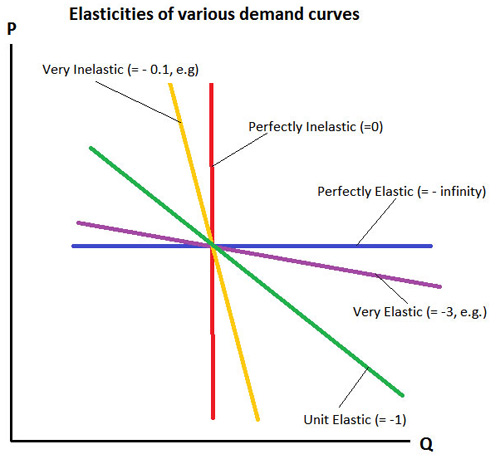4.2 Elasticity
Elasticity of Demand
https://youtu.be/J82_xd5XxXg
Elasticity of Demand is a measure of the responsiveness of quantity demanded to a change in price. It corresponds to the slope of the demand curve: if the demand curve is almost horizontal, the good is said to have elastic demand: when price goes down by a certain amount, quantity demanded increases by a lot. If, on the other hand, the demand curve is almost vertical, the good is said to have inelastic demand: when price goes down by a certain amount, quantity demanded doesn’t increase by very much.

What makes the demand for a good elastic or inelastic? The key is the availability of substitutes. The more close substitutes there are, the more elastic the demand. That’s because when the price of a certain good increases, people can easily stop buying that good and buy one of the substitutes instead. Quantity demanded will have a dramatic response to a change in price. (Example: people stop buying plastic toys and start buying wooden or cloth toys when the price of plastic toys goes up).
Consider instead a good with very few close substitutes (Example: air travel). When the price of those goods goes up, people have a hard time switching to other goods, so people are stuck paying the higher price for the good. Quantity demanded doesn’t change much when the price changes: these are inelastic goods.
The key idea: elasticity means escape. When consumers can easily escape into other markets, demand is elastic. When consumers can’t escape, demand is inelastic.
- In each part, identify which of the two goods is more likely to be inelastically demanded.
- Demand for tangerines; demand for fruit
- Demand for Exxon gasoline at the corner of 7th and Grand; demand for gasoline in the entire city
- Demand for insulin; demand for vitamins
- Demand for coffee; demand for Starbucks coffee
- Demand for textbooks for required courses; demand for novels for leisure reading
- Demand for gasoline in the short term; demand for gasoline in the long term
Answer:
- After more employers allow employees to telecommute, will the demand curve for cars be more elastic or more inelastic?
Answer:
Elasticity of Supply
https://youtu.be/gguIcyQzSog?list=PL-uRhZ_p-BM7GlKbOMUmEtA0Aj44i4SQp
Elasticity of supply measures how responsive the quantity supplied is to a change in price. If quantity supplied is very responsive (almost horizontal supply curve), we say supply is very elastic. But if quantity supplied is not responsive (almost vertical supply curve), we say supply is inelastic.
The main determinant of the elasticity of supply is how quickly per-unit costs increase with an increase in production. If sellers can increase production only by spending a lot more, supply is inelastic. But if sellers can increase production at a low cost, supply is elastic.
For example, take Picasso paintings and toothpicks. Sellers can easily increase toothpick production by running machines longer and adding more input wood, so the supply of toothpicks is elastic. Sellers can’t so easily increase the production of Picasso paintings: Picasso is no longer alive, and no longer making paintings. There is a fixed supply of Picasso paintings in the world, so the supply of Picasso paintings is perfectly inelastic.
- Which of these is more likely to be elastically supplied: supply of apples over the next growing season; supply of apples over the next decade?
Answer:
- If pesticides and fertilizers are banned, will the supply curve for food become more elastic or more inelastic?
Answer: